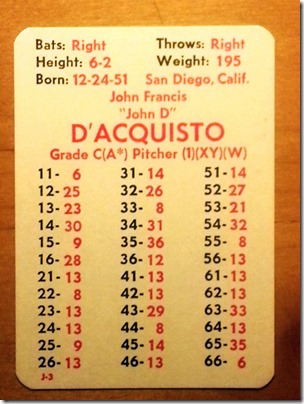Whatever happened to the C(A*) pitcher? Or for that matter, the D(B*)? Tom Zuppa sent me this 1978 John D’Acquisto APBA card as a reminder that these cards weren’t all that uncommon in the 1970s.
Usually, these cards were given to relievers with appropriately low ERAs. However, these relievers managed to start a game or two. Rather than give him a straight Grade A rating, they would get a split grade.
| Split | W | L | G | GS | GF | CG | SHO | SV | IP | H | BB | SO | ||
|---|---|---|---|---|---|---|---|---|---|---|---|---|---|---|
| 1978 Totals | 4 | 3 | .571 | 2.13 | 45 | 3 | 24 | 0 | 0 | 10 | 93.0 | 60 | 56 | 104 |
In D’Acquisto’s case, he made 42 relief appearances and started three games while putting up a nice 2.13 ERA.
Interestingly, D’Acquisto did better as starter in 1978:
| Split | W | L | G | GS | GF | SV | IP | ||
|---|---|---|---|---|---|---|---|---|---|
| as Starter | 1 | 1 | .500 | 1.37 | 3 | 3 | 0 | 0 | 19.2 |
| as Reliever | 3 | 2 | .600 | 2.33 | 42 | 0 | 24 | 10 | 73.1 |
As far as I know, APBA has never given a grade such as A(B*) or B(C*) where the starter grade is better than the reliever grade.
Two things I learned doing this post. One, John D’Acquisto’s last name is pronounced “DEE-ah-KWISS-toe” (I always thought it was “KEE-sto”).
Two, you can now get pitcher splits on how pitchers did by individual umpire on Baseball Reference. My friend Todd Ventresca who is an umpire might be interested in that.
Thanks, Tom!





Is it just me, or was Johnny D (as one of my friends used to call him) a really underappreciated reliever?